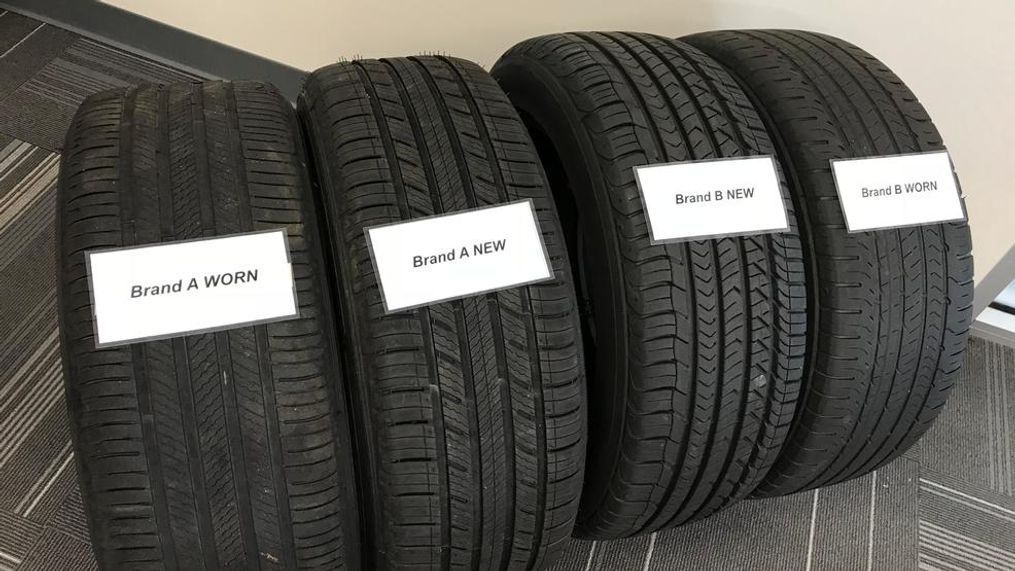There’s more to a tire than treads

GREENVILLE, S.C. — We accelerated up to about 47 mph and then hit cruise control to retain a constant speed when we hit the flooded pavement.
Then we slammed on the brakes.
We did the exercise four times with four different sets of tires all on 2018 Toyota Camrys. Two sets of tires were from Brand A, and two were from Brand B. Each brand then had one set of completely new tires and one worn down to 3/32nds.
We then witnessed a repeat of this exercise in 2018 Ford F-150s.
While there was certainly a difference between the new tires in stopping distance, there was a huge difference between the worn tires.
Though Michelin hosted this tire-testing event, we never learned which tires were theirs, or if both were theirs, or if neither were theirs.
Michelin’s point was simply this: Worn tires need to be tested, and the results need to be shared with consumers.
Yet, currently, the testing either isn’t being done or isn’t being shared publicly.
Michelin walked us through some of the testing it did, identifying tires by letters not brands.
One of the charts used showed how new tires testing well for grip don’t always test well when worn – but there are some that test better than others.
Wouldn’t you want to know which is which?
Unlike crash test ratings performed by NHTSA or the Insurance Institute for Highway Safety, no independent entity does worn-tire testing.
Oh yes, Consumer Reports does some tread testing, clearly showing that worn treads are bad. But Michelin argues that’s only part of the story.
The other part of the story involves the pattern of the tread and the tire rubber compound.
First, you want a tread pattern that will wear well over time, so that it has the same number of biting edges worn as it did when new. Brand A held up well with 44 biting edges maintained when it was ground down to 3/32nds. But Brand B went from 35 biting edges to 10.
Second, you need a rubber compound that will maintain its grip over time.
When someone says compound doesn’t matter, I actually have rubber samples in my freezer that I pull out to show the difference between summer, all-season and winter tires. The summer tire rubber is stiff as a board and the winter tire rubber is supple and grippy.
Compound matters – and it will vary from by manufacturer and tire type.
But right now, we’re making an educated guess, based on the manufacturers’ marketing claims, about which tires are best.
Let’s go back to the wet braking tests we performed for a minute and reiterate that the depth of tire treads of the worn tires for both brands were exactly the same. And yet, we experienced a huge difference between Brand A and Brand B worn tires. In some instances among these testing tires, worn tires from Brand A actually performed better than new tires from Brand B.
That’s something to ponder.
After the wet braking test, we went out to a wet handling course and did another exercise with Brand A and Brand B new and worn tires. This time, we were in Nissan Jukes, and the results were quite similar.
Though I noticed more slippage on the slick autocross, Brand A worn tires continually had better grip through slaloms and aggressive turns than Brand B – new or worn. In fact, with Brand B worn tires, I could have sworn I was on a sandy drift course. The only control I had was using the momentum of the sideways-sliding vehicle to make drifting turns.
The Bottom Line
If you’re looking for me to tie up this story with a neat bow, prepare to be disappointed.
There is currently no way to test whether those tires you bought for your vehicle will stand up over the test of time. All you have is the manufacturer’s word that they will.
You can look at Consumer Reports’ testing and see that more tread is better than less tread. But if you look at tires that have equally worn treads, which one is going to help you avoid crashing into the person who just slammed on the brakes in front of you?
I dunno. But I’d like to.
